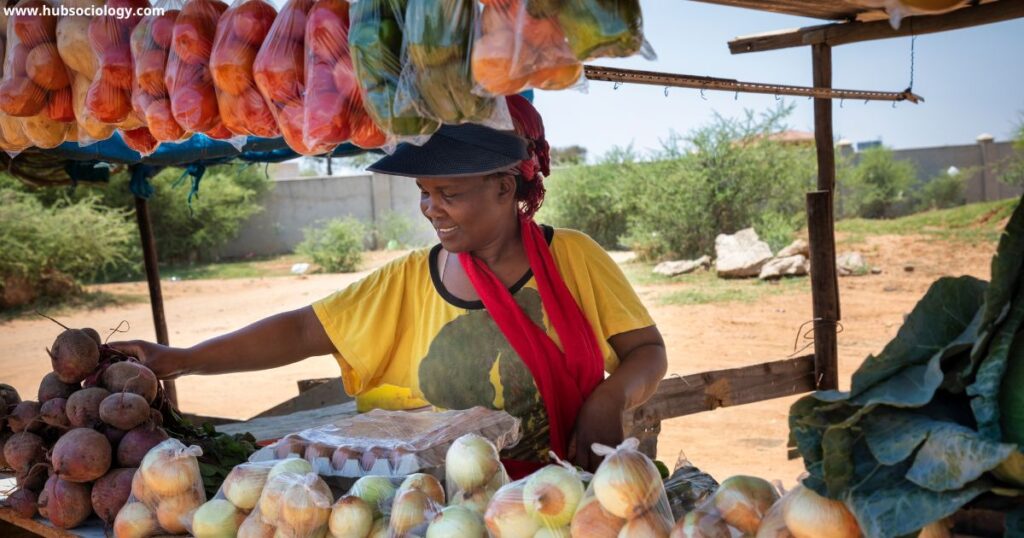The informal sector in urban India plays a crucial role in the economy, employing millions of workers across diverse occupations such as street vending, construction, domestic work, waste recycling, and gig-based jobs. Despite its economic significance, the informal sector is often characterized by precarious working conditions, lack of social security, and marginalization. Sociologically, the informal sector is witnessing the emergence of new social structures, shaped by urbanization, technological shifts, and changing labor dynamics. This article explores these evolving social structures in the informal sector through the lenses of class, caste, gender, labor organization, digital economy, and migration.

Table of Contents
Changing Class Structures and Economic Mobility
The informal sector in urban India is marked by diverse economic stratifications, where workers navigate new class dynamics influenced by urban growth and shifting labor markets.
- Fragmented Labor Class: Unlike traditional working-class structures, informal workers operate in highly decentralized, unregulated environments, often lacking collective bargaining power.
- Rise of Micro-Entrepreneurs: Many informal workers, such as street vendors and small-scale artisans, function as micro-entrepreneurs, reflecting new forms of economic agency.
- Class Mobility and Economic Instability: While some informal workers manage to transition into the lower middle class through entrepreneurial ventures, many remain trapped in cycles of debt and poverty due to unstable incomes.
- Informal Wealth Accumulation: Despite financial hardships, some segments, such as scrap dealers and middlemen in the supply chain, accumulate wealth and influence, reshaping traditional class boundaries.
More – Urban Society in India
Caste and Occupational Segmentation
Caste continues to influence the organization of labor in the informal sector, even as urbanization creates new occupational opportunities.
- Persistence of Traditional Caste-Based Occupations: Many Dalits and marginalized castes remain concentrated in sanitation work, manual scavenging, and waste management, highlighting structural inequalities.
- Inter-Caste Mobility: Urban spaces have provided limited avenues for inter-caste occupational mobility, particularly in sectors like street vending and gig economy jobs.
- Caste Networks in Employment: Many informal workers rely on caste-based networks for job opportunities, particularly in construction, domestic work, and garment production.
- Challenges to Caste-Based Exclusion: Government policies, NGO interventions, and legal safeguards are slowly challenging caste-based discrimination in the informal workforce.
Gender and Informal Labor
Women constitute a significant portion of the informal workforce, often facing gendered vulnerabilities, wage disparities, and socio-economic marginalization.

- Growth of Women-Led Informal Enterprises: Many women are engaged in home-based businesses, street vending, and self-help groups (SHGs), fostering economic empowerment.
- Gender Wage Gap and Labor Insecurity: Women in the informal sector often earn significantly less than their male counterparts, with limited access to labor rights.
- Household Responsibilities and Work Burden: Many women juggle informal work with domestic responsibilities, leading to a double burden of unpaid and paid labor.
- Feminization of Certain Informal Jobs: Domestic work, care work, and small-scale vending are highly feminized sectors, reinforcing gender-based occupational segmentation.
Labor Organization and Collective Action
Despite structural disadvantages, informal workers are forming new modes of labor organization and resistance.
- Street Vendors’ Unions and Associations: Organizations such as the National Association of Street Vendors of India (NASVI) are advocating for legal protections and policy reforms.
- Cooperatives and Self-Help Groups: Many workers are organizing into cooperatives to access credit, negotiate better wages, and improve working conditions.
- Digital Labor Platforms and Worker Networks: WhatsApp groups, social media, and digital forums have become key spaces for informal workers to share information and mobilize collectively.
- Strikes and Protest Movements: Informal workers, such as gig workers and contract laborers, have staged protests against exploitative conditions, demanding better wages and job security.
Technology and the Digital Economy
Digitalization is reshaping the informal labor market, creating both opportunities and challenges for workers.
- Gig Economy and Platform Work: App-based services like Uber, Swiggy, and Zomato have integrated informal workers into digital labor structures, altering traditional employment relations.
- Online Marketplaces for Informal Businesses: Platforms such as Instagram, WhatsApp, and local e-commerce sites enable informal workers to sell products and services directly to consumers.
- Financial Inclusion through Digital Payments: Mobile wallets and digital banking have facilitated financial inclusion for informal workers, reducing dependence on cash transactions.
- Algorithmic Control and Worker Exploitation: Gig workers face challenges such as unpredictable earnings, algorithm-driven work allocation, and lack of formal labor protections.
Migration and Urban Informality
Migration is a key factor in shaping labor structures within the informal sector, influencing economic survival strategies and social integration.
- Rural-to-Urban Migration and Informal Work: Migrants from rural areas form a large portion of informal labor in construction, domestic work, and street vending.
- Migrant Worker Precarity: Migrant workers often lack social security, legal protections, and stable housing, making them highly vulnerable to economic shocks.
- Emergence of Ethnic Labor Clusters: Many migrant communities form ethnic labor hubs in cities, creating informal networks that provide jobs and housing support.
- State Policies and Labor Rights: While some government initiatives aim to provide identity cards and social security benefits to migrant workers, many still remain excluded from formal welfare schemes.
Social Networks and Informal Solidarity
Despite economic hardships, informal workers create strong social networks and community ties that provide essential support systems.
- Community-Based Mutual Aid: Informal workers often rely on community-based lending circles and rotating savings groups to manage financial crises.
- Religious and Ethnic Associations: Faith-based and regional associations offer support in job placements, legal aid, and crisis management.
- Neighborhood-Based Networks: Slums and informal settlements serve as hubs of economic activity and social cohesion, enabling workers to sustain their livelihoods.
- Inter-Generational Informal Labor Transmission: Many workers inherit informal occupations from family members, reinforcing informal sector continuity across generations.
Challenges and Policy Implications
The informal sector’s evolving social structures present several challenges that require policy attention and intervention.

- Lack of Social Security and Legal Protections: Informal workers lack pensions, health insurance, and job security, necessitating stronger labor policies.
- Urban Housing and Basic Services: Many informal workers live in overcrowded slums with inadequate access to water, sanitation, and electricity.
- Impact of Automation and Economic Shifts: The rise of automation and changing urban economies may displace certain informal jobs, requiring reskilling initiatives.
- Need for Inclusive Urban Planning: Policies must integrate informal workers into urban development plans, ensuring access to markets, transport, and legal recognition.
Conclusion
The informal sector in urban India is undergoing profound transformations, driven by economic changes, migration, digitalization, and evolving labor relations. While informal workers continue to face precarious conditions, they are also shaping new social structures through entrepreneurial efforts, collective organization, and digital adaptation. Understanding these changes from a sociological perspective is crucial for formulating policies that promote inclusive, dignified, and equitable working conditions. The future of the informal sector will depend on how well urban India balances economic growth with social justice, ensuring that informal workers are recognized as vital contributors to the nation’s development.
Topic Related questions
5 Marks Questions (Short Answer)
- Define the informal sector and explain its significance in urban India.
- How does caste influence occupational segmentation in the informal sector?
- Mention two ways technology is reshaping the informal labor market in urban India.
- What are the key challenges faced by women in the informal workforce?
- How do migrant workers contribute to urban informal labor markets?
10 Marks Questions (Medium Answer)
- Discuss the role of social networks in supporting informal workers in urban India.
- How has the gig economy transformed employment structures in the informal sector?
- Explain how gender dynamics shape labor participation in urban informal work.
- Analyze the impact of rural-to-urban migration on the informal labor sector.
- What are the major labor organization strategies adopted by informal workers for collective bargaining?
15 Marks Questions (Long Answer/Essay Type)
- Examine the socio-economic implications of digitalization on informal labor in urban India.
- Discuss the interplay of caste, class, and gender in shaping labor conditions in the informal sector.
- How do urban policies and governance impact informal workers in Indian cities?
- Evaluate the role of self-help groups and cooperatives in empowering informal workers.
- Assess the impact of urbanization on the sustainability of informal employment in India.

5 thoughts on “New Social Structures in the Informal Sector of Urban India”